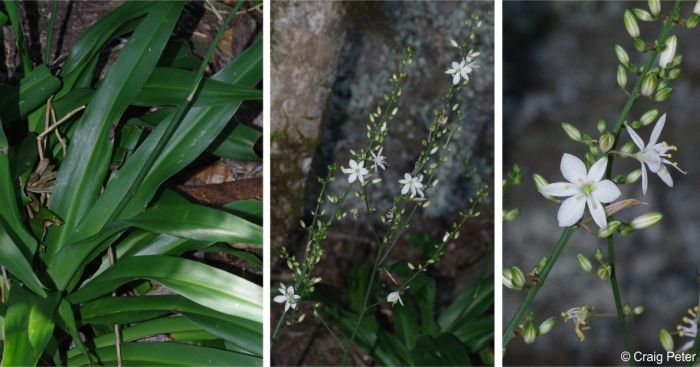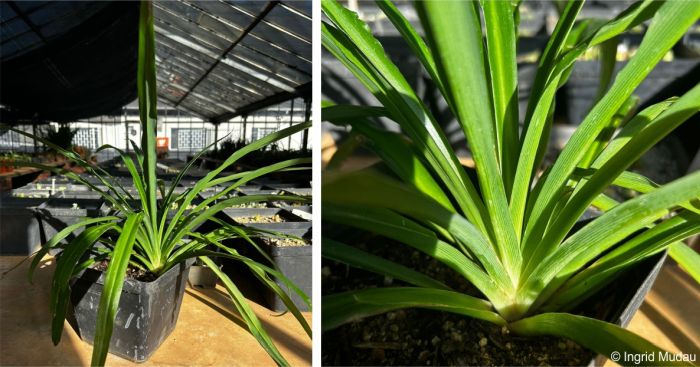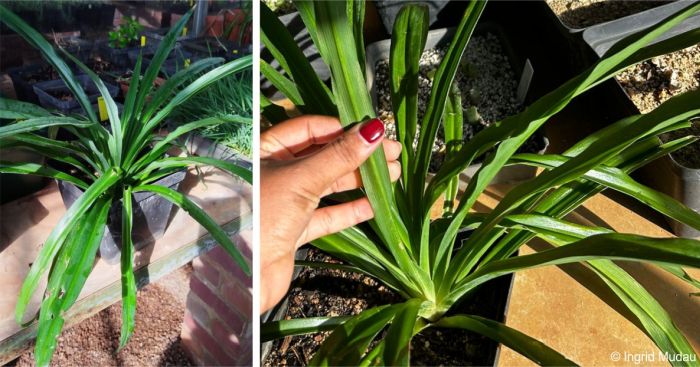Chlorophytum capense
Chlorophytum capense (L.) Voss
Family: Agavaceae
Common names: Cape spider plant, bracket plant
Introduction
Chlorophytum capense is a popular ornamental plant that does well in shade to full sun and is semi-hardy to frost and requires moderate water. It has fleshy roots, long strap-like leaves and spikes of star-shaped white flowers. It is used in landscapes and makes a rewarding pot plant.

Description
Description
Chlorophytum capense is an evergreen herbaceous perennial that spreads by means of a rhizome, forming clumps. It is an ornamental plant growing up to 600 mm tall, with narrow, green, linear, grass-like, arching leaves with tips that may touch the ground. They are alternately arranged on each side forming a rosette at the base. There are variegated varieties with striped yellow, white, or cream lines on the leaves. The plant produces an inflorescence up to 1 m tall, with white, star-shaped flowers that are borne in a branched raceme in summer (October to April). The flower has 6 stamens with white filaments and yellow anthers, and a style. The fruit is a capsule containing black seeds.

Conservation Status
Status
The conservation status of Chlorophytum capense is Least Concern (LC) according to the Red List of South African Plants, meaning the species is not threatened in its natural habitat.
Distribution and habitat
Distribution description
Chlorophytum capense is native to South Africa, where it occurs in the Eastern Cape Province in the Humansdorp and Albany Districts, growing in dry, shady vegetation on river banks, often near the sea, but now the species is being admired for its aesthetics and has been introduced in many different tropical regions worldwide.
Derivation of name and historical aspects
History
The name Chlorophytum is derived from the Greek words, chloros, meaning ‘green’ and phyton meaning ‘plant’. The species name capense means ‘of or from the Cape’, referring to the southern provinces of South Africa. This species is also known as the Cape spider plant, because it is similar to the spider plant, Chlorophytum comosum, so named for its rounded shape and long arching leaves with tips touching the ground, so that it resembles a spider. Chlorophytum capense was previously referred to as Anthericum elatum and Asphodelus capensis.
Chorophtyum is a large and taxonomically complex genus comprising of 203 accepted species distributed in the tropical and subtropical regions of the world, mostly in Africa, south Asia and Australia. Plants are evergreen perennials with a thick rhizomatous root system. The best known species is Chlorophytum comosum, commonly called spider plant or hen-and-chickens, that is grown as an ornamental garden plant, pot plant and indoor plant throughout the world. Chlorophytum capense and C. comosum look very similar and are easily mistaken for each other, however C. capense does not produce plantlets on its flowering stem, which are characteristic of C. comosum.

Ecology
Ecology
Chlorophytum capense grows in shaded bush and the plants can withstand drought periods. The white flowers attract insects which play a major role in pollination. Birds such as weavers benefit from harvesting the leaves of the plant to make their nests. In India, where local indigenous species of Chlorophytum are harvested from the wild for medicinal purposes, resulting in small populations that are at risk of extinction, a genetic diversity study revealed a low genetic diversity within species and a high genetic diversity between species, showing that species have diverged from each other and have a low rate of gene flow between species. Additionally, the species look very similar and populations are relatively close to each other. The lack of gene flow between species may be due to their mode of seed dispersal being unspecialized resulting in seeds not being dispersed far from the parent population, or because they reproduce mainly by vegetative (asexual) means. With their thick, rhizomatous roots, species in the genus can survive damage from destructive events such as frost, fire and trampling, and can resprout after a disturbance.
Uses
Use
Some species of Chlorophytum are cited to have medicinal properties, their roots are known to have antioxidant, immuno-modulatory and anti-inflammatory effects. In some instances, they are used as a rejuvenator, instant energy provider and also in the treatment of bronchitis, fractures and burns. Chlorophytum arundinaceum, C. borivilianum and C. comosum are reported as the most important and commercially recognized species of the genus.
Chlorophytum capense is famously known to look good in containers as an indoor plant and complements the outdoors as an edging plant or as a groundcover on landscapes.

Growing Chlorophytum capense
Grow
Chlorophytum capense is easily propagated through vegetative means (division) and seed. The division propagation method can be done by lifting a mature clump and dividing it into smaller clumps or individual plants and then repotting them as new plants, or by removing plantlets that are produced by the mother plant, which rarely occurs with Chlorophytum capense compared to Chlorophytum comosum. Sow seed in the warmer months, in composted soil for optimal growth. A mixture of 70% top soil and 30% compost can be used to propagate C. capense with the addition of a fertilizer before the growing season, in late winter/early spring (August).
References
- Ebedes, G. 2021. Chlorophytum comosum. Plantbook. Online. https://www.plantbook.co.za/chlorophytum-comosum/.
- Ebedes, G. 2021. Chlorophytum saundersiae, Plantbook. Online. https://www.plantbook.co.za/chlorophytum-saundersiae/.
- Joffe, P. & Oberholzer, T. 2012. Creative gardening with indigenous plants, a South African guide, Second edition. Briza Publications, Pretoria.
- Katoch, M., Kumar, R., Pal, V. & Ahuja, A. 2010. Identification of Chlorophytum species (C. borivilalum, C. arundinaceum, C. laxum, C. capense and C. comosum) using molecular markers. Industrial Crops and Products 32(3):389-393.
- Kubiak, P.J. 2009. Fire responses of bushveld plants after the January 1994 wildfires in northern Sydney. Cunninghamia 11(1):131-165.
- Manning, J. & Goldblatt, P. 2012. Plants of the Greater Cape Floristic Region 1: the Core Cape Flora. Strelitzia 29. South African National Biodiversity Institute, Pretoria.
- Obermeyer, A.A. 1962. A revision of the South African species of Anthericum, Chlorophytum and Trachyandra. Bothalia 7: 4, 730.
- Pati, S.M., et al. 2015. Analysis of genetic variability in endemic medicinal plants of genus Chlorophytum from the Indian subcontinent using amplified fragment length polymorphism marker. Comptes Rendus Biologies 338(12):838-845.
- Peter, C. 2023-11. Observation of Chlorophytum comosum, Dassie Krantz, Mountain Drive, Grahamstown, Eastern Cape. iNaturalist. Online. https://www.inaturalist.org/observations/192525770.
- Pienaar, K. & Smith, G.F. 2011. The southern African what flower is that? An essential guide to garden plants. Struik, Cape Town.
- Pienaar, K. 1987. The A-Z of garden flowers in South Africa. Struik, Cape Town.
- Plants of the World Online. Chlorophytum Ker Gawl. https://powo.science.kew.org/taxon/urn:lsid:ipni.org:names:24132-1. Accessed 17/06/24.
- Raimondo, D., Von Staden, L., Foden, W., Victor, J.E., Helme, N.A., Turner, R.C., Kamundi, D.A. & Manyama, P.A. (eds) 2009. Red list of South African plants. Strelitzia 25. South African National Biodiversity Institute, Pretoria.
- Van Jaarsveld, E. 2012. Chlorophytum comosum (Thunb.) Jaques. (Agavaceae). PlantZAfrica. Online. http://pza.sanbi.org/ Chlorophytum comosum.
- Vijaya, K.N. & Chavan, P.D. 2009. Chlorophytum borivilianum (Safed musli): A review. Pharmacognosy Reviews. 3(5):154-169.
Credits
Ramaboea Sefularo & Zandile Mazibuko
National Zoological Gardens
July 2024
Acknowledgements: the authors give special thanks to Ingrid Mudau for collecting the species and providing images, and Craig Peter for providing pictures on iNaturalist.
Plant Attributes:
Plant Type: Ground Cover, Perennial
SA Distribution: Eastern Cape
Soil type: Sandy, Loam
Flowering season: Early Summer, Late Summer
PH:
Flower colour: White
Aspect: Full Sun, Morning Sun (Semi Shade), Afternoon Sun (Semi Shade)
Gardening skill: Easy
Special Features:
Horticultural zones











Rate this article
Article well written and informative
Rate this plant
Is this an interesting plant?
Login to add your Comment
Back to topNot registered yet? Click here to register.